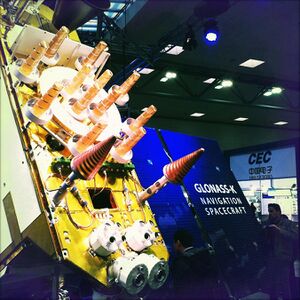Engineering:Kosmos 2501
 Model of a GLONASS-K satellite | |
| Mission type | Navigation |
|---|---|
| Operator | VKO |
| COSPAR ID | 2014-075A |
| SATCAT no. | 40315 |
| Mission duration | 10 years |
| Spacecraft properties | |
| Spacecraft type | Uragan-K1 |
| Bus | Ekspress-1000A |
| Manufacturer | ISS Reshetnev |
| Launch mass | 935 kg |
| Start of mission | |
| Launch date | 30 November 2014, 21:52:26 UTC |
| Rocket | Soyuz-2-1b / Fregat-M |
| Launch site | Plesetsk, Site 43/4 |
| Orbital parameters | |
| Reference system | Geocentric |
| Regime | Medium Earth |
| Perigee altitude | 19155 km |
| Apogee altitude | 19199 km |
| Inclination | 64,8° |
| Period | 677.6 minutes |
Kosmos 2501 (Russian: Космос 2501 meaning Cosmos 2501), also known as Glonass-K1 No.12L is a Russian navigation satellite which was launched in 2014. The second Glonass-K satellite to be launched, it is the second of two Glonass-K1 spacecraft which will serve as prototypes for the operational Glonass-K2 spacecraft.[1]
Kosmos 2501 is a 935-kilogram (2,061 lb) satellite, which was built by ISS Reshetnev based on the Ekspress-1000A satellite bus. The spacecraft has three-axis stabilisation to keep it in the correct orientation, and will broadcast signals in the L1, L2 and L3 navigation bands for Russian military and commercial users.[1] In addition to its navigation payloads, the satellite also carries a Cospas-Sarsat search and rescue payload.[1]
The satellite is located in a medium Earth orbit with a perigee of 19,155 kilometres (11,902 mi), an apogee of 19,199 kilometres (11,930 mi), and 64.8° of inclination.[2] It is equipped with two solar panels to generate power, and is expected to remain in service for ten years.
Kosmos 2501 was launched from Site 43/4 at the Plesetsk Cosmodrome in northwest Russia. A Soyuz-2.1b carrier rocket with a Fregat upper stage was used to perform the launch, which took place at 21:52:26 UTC on 30 November 2014.[3] The launch successfully placed the satellite into a Medium Earth orbit. It subsequently received its Kosmos designation, and the International Designator 2014-075A. The United States Space Command assigned it the Satellite Catalog Number 40315.
References
- ↑ 1.0 1.1 1.2 Krebs, Gunter. "Uragan-K1 (GLONASS-K1)". Gunter's Space Page. http://space.skyrocket.de/doc_sdat/uragan-k1.htm.
- ↑ McDowell, Jonathan. "Jonathan's Space Report Issue 706". Jonathan's Space Report. http://www.planet4589.org/space/jsr/back/news.706.
- ↑ Zak, Anatoly. "GLONASS-K No. 12 satellite". RussianSpaceWeb. http://www.russianspaceweb.com/glonass_k_no12.html.
 |

